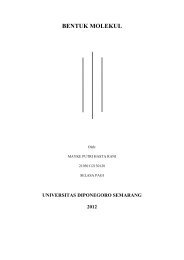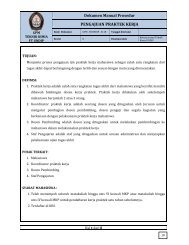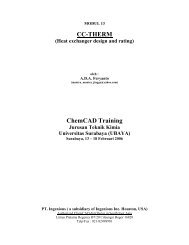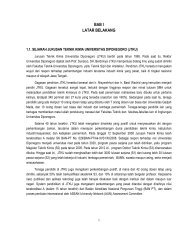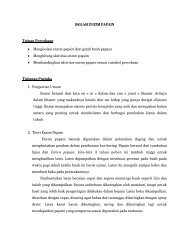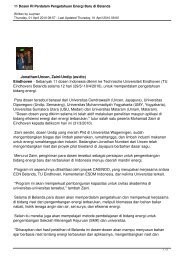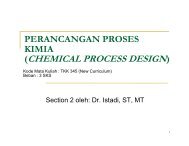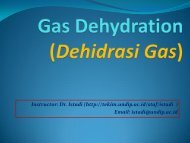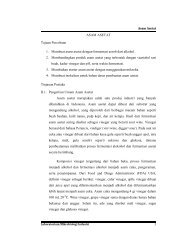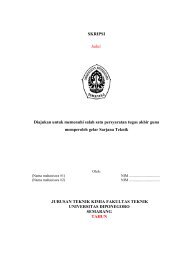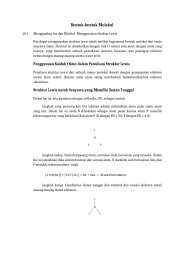Vinyl Acetate Monomer Process 10
Vinyl Acetate Monomer Process 10
Vinyl Acetate Monomer Process 10
Create successful ePaper yourself
Turn your PDF publications into a flip-book with our unique Google optimized e-Paper software.
3<strong>10</strong> <strong>10</strong> <strong>Vinyl</strong> <strong>Acetate</strong> <strong>Monomer</strong> <strong>Process</strong><br />
Figure <strong>10</strong>.12 Dynamic simulation results.<br />
increases from 455 K (at 0.8 m from reactor inlet) to 469 K (at 1.2 m from inlet).<br />
The higher temperature results in higher reaction rates, less reactants being recycled.<br />
The gas recycle is the fastest, and the ethylene feed is the first to be adjusted.<br />
Then, more oxygen is added by the concentration controller. The dynamics of the<br />
liquid recycle is slower and it takes about 0.5 hours until the acetic acid feed<br />
reaches the new stationary value. The vinyl acetate production - rate increases from<br />
154 to 171 kmol/h. At time t = 3 h, the coolant temperature is reduced to 400 K,<br />
and the simulation is run for another 2 h. The maximum reactor temperature<br />
drops to 452 K (near the reactor inlet) and the production rate is decreased to<br />
134 kmol/h. During the entire simulation, the oxygen concentration stays very<br />
close to the setpoint of 6%. Moreover, the concentration of the vinyl acetate product<br />
is above the 99.98% specification.<br />
A vinyl acetate plant with a different structure of the separation section has been<br />
suggested as test case for plantwide control design procedures [5, 6] . Similarly to<br />
our results, Luyben and co - workers [7, 17] proposed to fix the reactor - inlet flow<br />
rate of acetic acid and to use the fresh feed to control the inventory in the bottom<br />
of the acetic - acid distillation column. The two control strategies are equivalent<br />
from a steady state point of view. However, Olsen et al. [18] showed that Luyben’s<br />
structure has an unfavourable dynamics due to the large lag between the manipulated<br />
and controlled variables. The other important control loops in [7] paired the<br />
oxygen feed with oxygen concentration, and ethylene feed with pressure in the<br />
system. The production rate was also manipulated by the setpoint of reactor temperature<br />
controller. Chen and McAvoy [19] applied a methodology where several<br />
control structures, generated on heuristic grounds, were evaluated using a linear<br />
dynamic model and optimal control. Their results also indicate that fixing the<br />
reactor - inlet flows is the recommended strategy.<br />
<strong>10</strong>.9<br />
Conclusions<br />
The case study of the synthesis of vinyl acetate emphasizes the benefits of a systematic<br />
design based on the analysis of the reactor/separation/recycles structure.<br />
The core of the process is the chemical reactor, whose behavior in recycle depends



